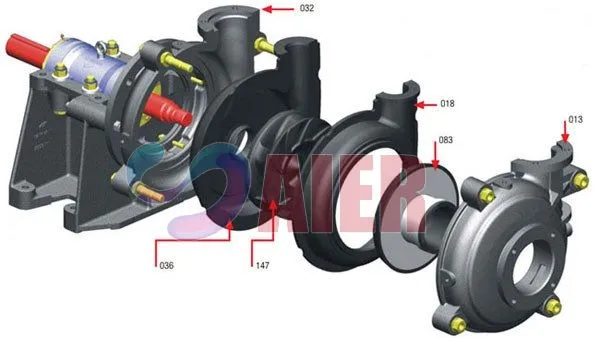Δεκ . 07, 2024 11:58 Back to list
Centrifugal Slurry Pump Liner Manufacturing Processes and Key Factors for Success
Understanding Centrifugal Slurry Pump Liners A Focus on Manufacturing
Centrifugal slurry pumps are crucial in various industrial applications, particularly in the mining, mineral processing, and dredging sectors. These pumps are designed to handle a mixture of solids and fluids, known as slurry, making them essential for transporting materials like ores, coal, and sediments. An integral component of these pumps is the liner, which protects the pump casing from the abrasive effects of slurry. This article explores the factories that manufacture centrifugal slurry pump liners, focusing on their production processes, materials used, and the importance of quality standards.
The Importance of Pump Liners
Centrifugal slurry pump liners serve several critical functions. Primarily, they act as a protective barrier between the abrasive slurry and the pump casing, thereby extending the life of the pump and reducing maintenance costs. The choice of liner material significantly affects the pump's performance. Liners need to withstand high wear rates and resist corrosion due to the chemical properties of the slurry. Thus, manufacturers prioritize durability and quality when producing these components.
Materials Used in Liner Manufacturing
The manufacturing of centrifugal slurry pump liners involves various materials. The most common materials include
1. Rubber Rubber liners are favored for their excellent wear resistance and flexibility. They are suitable for handling coarse particles and are effective in preventing corrosion due to their inherent elasticity and resilience.
2. Metal Metal liners, often made from alloyed steel, are robust and can withstand heavier wear conditions. They are ideal for applications where the slurry contains large, sharp-edged particles.
3. Ceramics Advanced ceramic materials are also used in high-performance liners due to their exceptional hardness. Ceramic liners provide superior wear resistance, making them suitable for the harshest operating environments.
Manufacturers often evaluate the specific application requirements, including the type of slurry, flow rates, and the presence of corrosive materials, to select the appropriate liner material
.Manufacturing Processes
centrifugal slurry pump liner factories

The production of centrifugal slurry pump liners typically involves several key processes
1. Material Preparation The first step is to procure raw materials in the required specifications. For rubber liners, this may involve mixing rubber compounds with additives, while metal liners may require sourcing alloyed steel in specified grades.
2. Molding and Forming For rubber liners, the mixing compound is poured into molds, where it is shaped and cured under heat and pressure. Metal liners are often formed through casting or machining, where precise dimensions are critical to ensure a perfect fit within the pump casing.
3. Quality Control After forming, each liner undergoes rigorous quality control testing. This includes checks for dimensional accuracy, surface finish, and material integrity. Any defects can lead to severe operational issues, making this step vital in the manufacturing process.
4. Coating and Finishing Depending on the material, liners may receive additional coatings or treatments to enhance corrosion resistance or improve their wear characteristics. This step is crucial, especially in applications where the slurry is chemically aggressive.
Importance of Quality Standards
Quality standards are paramount in the manufacturing of centrifugal slurry pump liners. Factories must adhere to international standards such as ISO 9001, which governs quality management systems. Such adherence ensures that the products meet customer expectations and regulatory requirements. Manufacturers conduct regular audits and invest in training their workforce to maintain these standards.
Additionally, research and development play a significant role in improving the effectiveness of slurry pump liners. Continuous innovations help manufacturers stay competitive by enhancing the longevity and performance of their products.
Conclusion
In summary, the manufacturing of centrifugal slurry pump liners is a complex process that requires careful consideration of materials, manufacturing techniques, and quality standards. As industries continue to seek efficiencies and cost-saving measures, the role of high-quality liners cannot be overstated. By investing in reliable manufacturing practices and advanced materials, factories are positioned to meet the growing demands of the market, ensuring that centrifugal slurry pumps operate at optimal levels, even in the most challenging environments. This focus on quality and innovation will only enhance the overall efficacy and sustainability of industrial operations reliant on slurry transport.
-
High-Efficiency Slurry Sand Pump from Leading China Manufacturer – Durable & Reliable Solutions
NewsJul.07,2025
-
High-Quality Slurry Pump Made in China Durable Steel Mill Slurry Pump & Parts
NewsJul.07,2025
-
High Quality Excavator Dredge Pump Manufacturer & Suppliers from China – Reliable, Durable, Efficient Solutions
NewsJul.07,2025
-
Wholesale Slurry Pump Closed Impeller Supplier High Efficiency China Slurry Pump Closed Impeller
NewsJul.06,2025
-
High Quality Warman Slurry Pump Drawings Supplier & Factory Reliable Customization
NewsJul.06,2025
-
China SP Slurry Pump Supplier – Vertical Sump Pump Rubber Lined Manufacturer & Factory
NewsJul.05,2025
